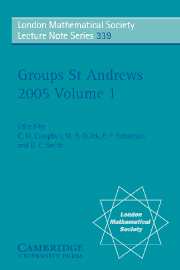Book contents
- Frontmatter
- Contents
- Introduction
- Aspects of infinite permutation groups
- Self-similarity and branching in group theory
- On surface groups: motivating examples in combinatorial group theory
- Nilpotent p-algebras and factorized p-groups
- Classification of finite groups by the number of element centralizers
- Algorithmic use of the Mal'cev correspondence
- Minimal but inefficient presentations for semi-direct products of finite cyclic monoids
- The modular isomorphism problem for finite p-groups with a cyclic subgroup of index p2
- On one-generated formations
- New results on products of finite groups
- Radical locally finite T-groups
- Explicit tilting complexes for the Broué conjecture on 3-blocks
- Conjugacy classes of p-regular elements in p-solvable groups
- An algorithm for the unit group of the Burnside ring of a finite group
- Integral group ring of the first Mathieu simple group
- Embedding properties in direct products
- Malcev presentations for subsemigroups of groups — a survey
- Finite groups with extremal conditions on sizes of conjugacy classes and on degrees of irreducible characters
- Conjugacy class structure in simple algebraic groups
- On automorphisms of products of groups
- Linear groups with infinite central dimension
- G-automata, counter languages and the Chomsky hierarchy
- An embedding theorem for groups universally equivalent to free nilpotent groups
- Irreducible word problems in groups
- Recent growth results
The modular isomorphism problem for finite p-groups with a cyclic subgroup of index p2
Published online by Cambridge University Press: 07 May 2010
- Frontmatter
- Contents
- Introduction
- Aspects of infinite permutation groups
- Self-similarity and branching in group theory
- On surface groups: motivating examples in combinatorial group theory
- Nilpotent p-algebras and factorized p-groups
- Classification of finite groups by the number of element centralizers
- Algorithmic use of the Mal'cev correspondence
- Minimal but inefficient presentations for semi-direct products of finite cyclic monoids
- The modular isomorphism problem for finite p-groups with a cyclic subgroup of index p2
- On one-generated formations
- New results on products of finite groups
- Radical locally finite T-groups
- Explicit tilting complexes for the Broué conjecture on 3-blocks
- Conjugacy classes of p-regular elements in p-solvable groups
- An algorithm for the unit group of the Burnside ring of a finite group
- Integral group ring of the first Mathieu simple group
- Embedding properties in direct products
- Malcev presentations for subsemigroups of groups — a survey
- Finite groups with extremal conditions on sizes of conjugacy classes and on degrees of irreducible characters
- Conjugacy class structure in simple algebraic groups
- On automorphisms of products of groups
- Linear groups with infinite central dimension
- G-automata, counter languages and the Chomsky hierarchy
- An embedding theorem for groups universally equivalent to free nilpotent groups
- Irreducible word problems in groups
- Recent growth results
Summary
Abstract
Let p be a prime number, G be a finite p-group and K be a field of characteristic p. The Modular Isomorphism Problem (MIP) asks whether the group algebra KG determines the group G. Dealing with MIP, we investigated a question whether the nilpotency class of a finite p-group is determined by its modular group algebra over the field of p elements. We give a positive answer to this question provided one of the following conditions holds: (i) exp G = p; (ii) c1(G) = 2; (iii) G' is cyclic; (iv) G is a group of maximal class and contains an abelian subgroup of index p.
As a consequence, the positive solution of MIP for all p-groups containing a cyclic subgroup of index p2 was obtained.
Introduction
Though the Modular Isomorphism Problem is known for more than 50 years, up to now it remains open. It was solved only for some classes of p-groups, in particular:
abelian p-groups (Deskins [10]; alternate proof by Coleman [9]);
p-groups of class 2 with elementary abelian commutator subgroup (Sandling, theorem 6.25 in [22]);
metacyclic p-groups (for p > 3 by Bagiński [1]; completed by Sandling [24])
2-groups of maximal class (Carlson [8]; alternate proof by Bagiński [2]);
p-groups of maximal class, p≠2, when |G| ≤ pp+1 and G contains an abelian maximal subgroup (Caranti and Bagiński [4]);
elementary abelian-by-cyclic groups (Bagiński [3]);
p-groups with the center of index p2 (Drensky [11]),
- Type
- Chapter
- Information
- Groups St Andrews 2005 , pp. 186 - 193Publisher: Cambridge University PressPrint publication year: 2007
- 6
- Cited by

